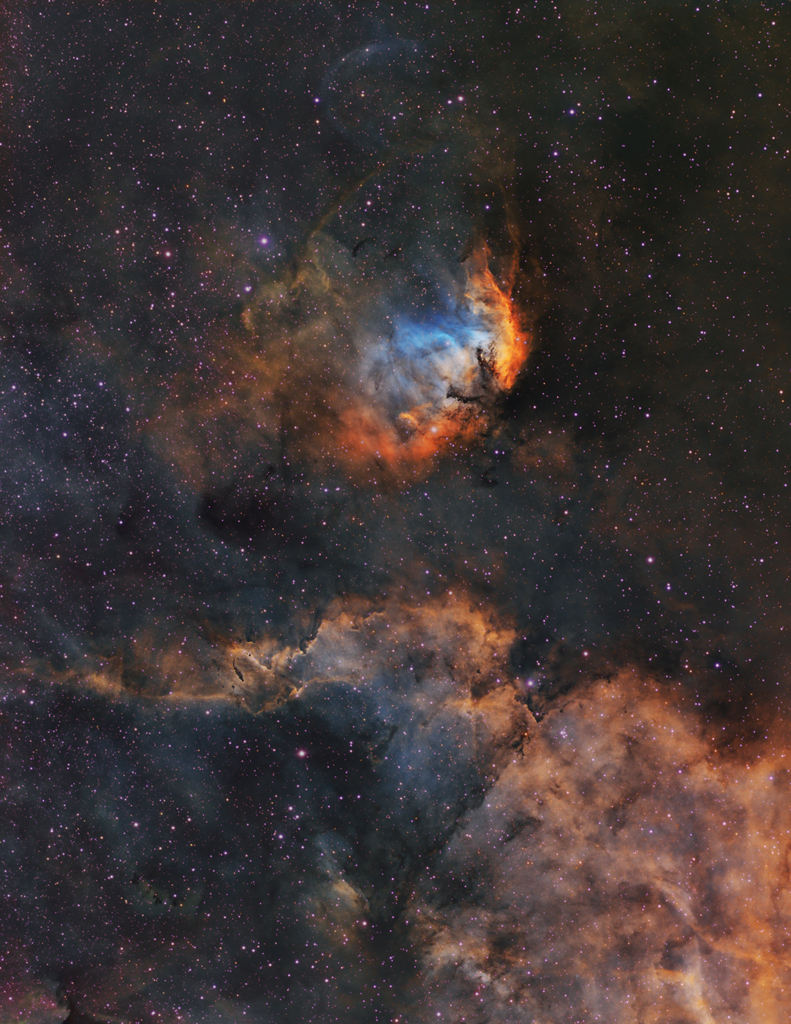29. July 2021
鬱金香星雲 kah 天鵝座 X-1

探索宇宙1!逐工會揀一幅無仝款 ê 影像抑是相片,𤆬你熟似咱這个迷人 ê 宇宙,閣有專業天文學者2為你3解說4。
- 原始文章:The Tulip and Cygnus X-1
- 影像來源 kah 版權:Carlos Uriarte
- 台文翻譯:An-Li Tsai (NCU)
[漢羅] 鬱金香星雲 kah 天鵝座 X-1
這張長長 ê 望遠鏡影像 是綴著咱 ê 銀河盤 ùi 有豐富星雲 ê 天鵝 座方向去看。 這个星雲一般是叫做鬱金香星雲。 Tī 中央面頂上光 ê 發光雲是 ùi 星際氣體 kah 塗粉來 ê。 伊 tī 1959 年 天文學家 Stewart Sharpless 編 ê 天體目錄內底揣會著,編做 Sh2-101。 這个美麗 ê 鬱金香星系有 70 光年闊,伊 to̍h 開 tī 8000 光年遠 ê 所在。 這是用哈伯色盤來顯像 ê,星雲 leh 發光 ê 是,紅色 ê 硫磺,青色 ê 水素、kah 藍色 ê 酸素。 Ùi 少年高能恆星來 ê 紫外光輻射 to̍h tī 天鵝座 OB3 星協 ê 邊仔。 包括有 O 型星 HDE 227018,伊 kā 鬱金香星雲內底 ê 原子 離子化,發出發射光。 Tī 這个視場內底是微類星體 天鵝座 X-1。 伊 tùi 咱地球來講是上強 ê X-光天體之一。 這个較暗 ê 藍色彎曲衝擊波前小可仔看有,是烏洞吸積盤內底 ê 噴流 kā 驅動 ê。 伊 to̍h tī 這个宇宙鬱金香花葉 ê 面頂,to̍h 是這幅影像頂懸 ê 所在。
[POJ] Ut-kim-hiong seng-hûn kah Thian-gô-chō X-it
Chit-tiuⁿ tn̂g-tn̂g ê bōng-oán-kiàⁿ iáⁿ-siōng sī tòe-tio̍h lán ê Gîn-hô-pôaⁿ ùi ū hong-hù seng-hûn ê Thian-gô-chō hong-hiòng khì khòaⁿ. Chi̍t-ê seng-hûn it-poaⁿ sī kiò-chò Ut-kim-hiong seng-hûn. Tī tiong-ng bīn-téng siōng-kng ê hoat-kng-hûn sī ùi seng-chè-khì-thé kah thô͘-hún lâi ê. I tī i̍t-kiú-ngó͘-kiú nî thian-bûn-ha̍k-ka Stewart Sharpless pian ê thian-thé bo̍k-lo̍k lāi-té chhōe-ē-tio̍h, pian-chò Sh-jī chi it-khòng-it. Chit-ê bí-lē ê Ut-kim-hiong seng-hē ū chhit-cha̍p kng-nî khoah, i to̍h khui tī peh-chheng kng-nî hn̄g ê só͘-chāi. Che sī iōng Ha-peh-sek-pôaⁿ lâi hiān-siōng ê, seng-hûn leh hoat-kng ê sī, âng-sek ê liû-hông, chheⁿ-sek ê chúi-sò͘, kah nâ-sek ê sng-sò͘. Ùi siàu-liân ko-lêng hêng-chhiⁿ lâi ê chí-gōa-kng hok-siā to̍h tī Thian-gō͘-chō OB-sam hêng-hiap ê piⁿ-á. Pau-koah ū O-hêng chhiⁿ HDE jī-jī-chhit-khóng-it-pat, i kā Ut-kim-hiong seng-hûn lāi-té ê goân-chú lî-chú-hòa, hoat-chhut hoat-siā-kng. Tī chi̍t-ê sī-tiûⁿ lāi-té sī bî-lūi-chhiⁿ-thé Thian-gô-chō X-it. I tùi lán Tē-kiû lâi-kóng sī siōng-kiông ê X-kng thian-thé chi-it. Chit-ê khah-àm ê nâ-sek oan-khiau chhiong-kek-phō-chiân sió-khóa-á khòaⁿ-ū, sī o͘-tōng khip-chek-pôaⁿ lāi-té ê phùn-liû kā khu-tōng ê. I to̍h tī chi̍t-ê ú-tiū ut-kim-hiong hoe-hio̍h ê bīn-téng, to̍h sī chit-pak-tô͘ téng-koân ê só͘-chāi.
[KIP] Ut-kim-hiong sing-hûn kah Thian-gô-tsō X-it
Tsit-tiunn tn̂g-tn̂g ê bōng-uán-kiànn iánn-siōng sī tuè-tio̍h lán ê Gîn-hô-puânn uì ū hong-hù sing-hûn ê Thian-gô-tsō hong-hiòng khì khuànn. Tsi̍t-ê sing-hûn it-puann sī kiò-tsò Ut-kim-hiong sing-hûn. Tī tiong-ng bīn-tíng siōng-kng ê huat-kng-hûn sī uì sing-tsè-khì-thé kah thôo-hún lâi ê. I tī i̍t-kiú-ngóo-kiú nî thian-bûn-ha̍k-ka Stewart Sharpless pian ê thian-thé bo̍k-lo̍k lāi-té tshuē-ē-tio̍h, pian-tsò Sh-jī tsi it-khòng-it. Tsit-ê bí-lē ê Ut-kim-hiong sing-hē ū tshit-tsa̍p kng-nî khuah, i to̍h khui tī peh-tshing kng-nî hn̄g ê sóo-tsāi. Tse sī iōng Ha-peh-sik-puânn lâi hiān-siōng ê, sing-hûn leh huat-kng ê sī, âng-sik ê liû-hông, tshenn-sik ê tsuí-sòo, kah nâ-sik ê sng-sòo. Uì siàu-liân ko-lîng hîng-tshinn lâi ê tsí-guā-kng hok-siā to̍h tī Thian-gōo-tsō OB-sam hîng-hiap ê pinn-á. Pau-kuah ū O-hîng tshinn HDE jī-jī-tshit-khóng-it-pat, i kā Ut-kim-hiong sing-hûn lāi-té ê guân-tsú lî-tsú-huà, huat-tshut huat-siā-kng. Tī tsi̍t-ê sī-tiûnn lāi-té sī bî-luī-tshinn-thé Thian-gô-tsō X-it. I tuì lán Tē-kiû lâi-kóng sī siōng-kiông ê X-kng thian-thé tsi-it. Tsit-ê khah-àm ê nâ-sik uan-khiau tshiong-kik-phō-tsiân sió-khuá-á khuànn-ū, sī oo-tōng khip-tsik-puânn lāi-té ê phùn-liû kā khu-tōng ê. I to̍h tī tsi̍t-ê ú-tiū ut-kim-hiong hue-hio̍h ê bīn-tíng, to̍h sī tsit-pak-tôo tíng-kuân ê sóo-tsāi.
[English] The Tulip and Cygnus X-1
This tall telescopic field of view looks out along the plane of our Milky Way Galaxy toward the nebula rich constellation Cygnus the Swan. Popularly called the Tulip Nebula, the brightest glowing cloud of interstellar gas and dust above center is also found in the 1959 catalog by astronomer Stewart Sharpless as Sh2-101. Nearly 70 light-years across the complex and beautiful Tulip Nebula blossoms about 8,000 light-years away, shown in a Hubble palette image that maps the glow of the nebula's sulfur, hydrogen, and oxygen ions into red, green, and blue colors. Ultraviolet radiation from young energetic stars at the edge of the Cygnus OB3 association, including O star HDE 227018, ionizes the atoms and powers the emission from the Tulip Nebula. Also in the field of view is microquasar Cygnus X-1, one of the strongest X-ray sources in planet Earth's sky. Driven by powerful jets from a black hole accretion disk, its fainter bluish curved shock front is only just visible though, directly above the cosmic Tulip's petals near the top of the frame.
詞彙學習
| 漢羅 | POJ | KIP | 華語 | English |
|---|---|---|---|---|
| 天鵝座 | Thian-gô-chō | Thian-gô-tsō | 天鵝座 | the constellation Cygnus |
| 鬱金香星雲 | Ut-kim-hiong seng-hûn | Ut-kim-hiong sing-hûn | 鬱金香星雲 | Tulip Nebula |
| 哈伯色盤 | Ha-peh-sek-pôaⁿ | Ha-peh-sik-puânn | 哈伯色盤 | Hubble palette |
| 硫磺 | liû-hông | liû-hông | 硫 | sulfur |
| 水素 | chúi-sò͘ | tsuí-sòo | 氫 | hydrogen |
| 酸素 | sng-sò͘ | sng-sòo | 氧 | oxygen |
| 紫外光輻射 | chí-gōa-kng hok-siā | tsí-guā-kng hok-siā | 紫外光輻射 | ultraviolet radiation |
| OB3 星協 | OB-sam seng-hiap | OB-sam sing-hiap | OB3 星協 | OB3 association |
| O 型星 | O-hêng chhiⁿ | O-hîng tshinn | O 型星 | O star |
| 微類星體 | bî-lūi-chhiⁿ-thé | bî-luī-tshinn-thé | 微類星體 | microquasar |
| 衝擊波前 | chhiong-kek-pho-chiân | tshiong-kik-pho-tsiân | 衝擊波前 | shock front |
| 吸積盤 | khip-chek-pôaⁿ | khip-tsik-puânn | 吸積盤 | accretion disk |
| 噴流 | phùn-liû | phùn-liû | 噴流 | jet |
| 花葉 | hoe-hio̍h | hue-hio̍h | 花瓣 | petal |